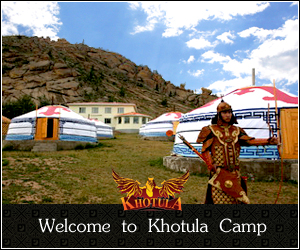Godil and Bayanbulag Ruin in Umnogobi Aimag
Godil Ruin
Godil Khuree or Ruin locates half kilometers from Balgas Khural Ruin, in the territory of Umnugobi aimag. It took the name of the nearby hill, Godil. Godil Ruin //sometimes Godil Khuree/ was mentioned in the sutra of Van Gun. In XVIII century, here was farm of Manchu troops. It suggests that the existence of town before it according to the historical record saying that grain was distributed from Godil Ruin and local people talk that it is similar to other cities of Togoontumur Khaan /1333-1368/. Godil Ruin was surrounded by thick walls of 232-237 steps /south and north/ and 210-233 steps /west and east/. It had houses which were attached to the wall. There are several remaining of watch towers on the walls. Also there is only one remaining of gate. Inside of the stronghold was almost covered with weeds and bushes, so it became hard to calculate the numbers of buildings. In 1913, four watchtowers in the corner and two side watchtowers of the front gate were clearly seen and if one searches a little he can easily find pieces of plate and pot without pattern. In the report of Kh.Perlee “Reconnaissance study in the areas of Umnugobi and Uvurkhangai” in 1961, it says that it was a farming center of Manchu troops in XVIII century.
Bayanbulag ruin
There is a ruin in the territory of Nomgon soum, Umnugobi aimag, 30 kilometers in the south of the soum center. The ruin was greatly eroded by wind, rain and animal. Only the north wing was less damaged and the rest is totally disappeared. Under the elevated land, there are two mounts, connected with each other, and they were waste disposal area, according to Kh.Perlee. The wall was built by pressing earth and north part wall is 180 meters long and 10-16 meters thick, while west wall is 110 meters long. Two heights of the north wing are about two meters tall and they were watch towers. The wall faces directly to the north.
In 1957, Kh.Perlee studied it and made basic mapping and found arrowhead with bronze stem and clay pots of Huns period from the south side of wall, which was waste disposal area. Also remaining of clay burning and iron were found. In 1976 D.Navaan made testing excavation, found u-shu coin, unknown bronze item and broken pieces of clay pots and determined their dates as the period of Huns and XII-XIV century. In 1990, “Expedition to trace Huns history” Institute of History, the Science Academy of Mongolia, excavated Bayanbulagiin Ruin and unearthed important relics and items such as clay pots, bronze arrowhead, u-shu zoos, various iron items, broken bronze mirror and bronze stamp. As for the items that were found from the site convince that it is related to Hun State, but some other researchers say that it is Jao Sin Chen ruin, built for the general Jao Sin who joined Hun State from Han in B.C. 123, after closely comparing with the Chinese sources.












